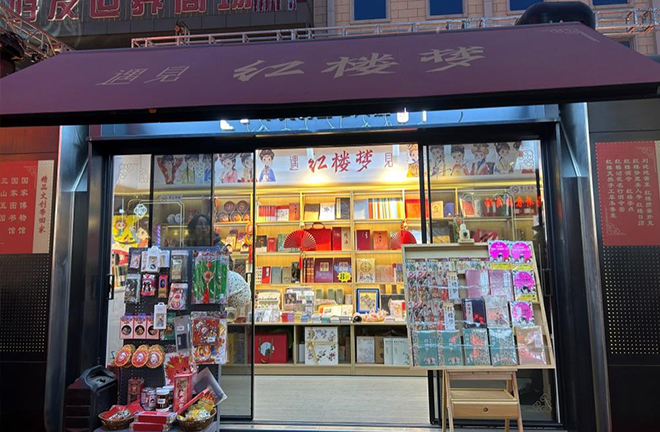Seminar reviews centurial classical literary studies

A bookstall themed around A Dream of Red Mansions in the Wangfujing Pedestrian Street in Beijing Photo: Yang Lanlan/CSST
A seminar on classical literature studies and Literary Heritage took place in Beijing in mid-January, coinciding with the 120th anniversary of Lin Chuanjia’s The History of Chinese Literature. Attendees refined centennial classic literary research for the inheritance and development of classical treasures.
Han and Tang literature
This conference also aimed to commemorate the 70th anniversary of the founding of Literary Heritage. “The journal not only represents a wind vane for cutting-edge research, but also cultivates rising academic stars, and witnesses the growth of academic celebrities,” said Du Xiaoqin, director of the Department of Chinese Language and Culture at Peking University (PKU).
The literary works, stylistic features, and document forms prior to the Tang Dynasty (618–907), as well as the interdisciplinary study of literature and Confucian classics, historiography, and philosophy, have become hot research topics. Xu Jianwei, a professor from the School of Liberal Arts at Renmin University of China, re-examined the establishment of the Imperial College in the early Western Han Dynasty (202 BCE–8 CE), contending that in the fifth year of Yuanguang (130 BCE), the system of the Imperial College was established, as Gongsun Hong suggested broadening the path of official career for students.
Ma Shinian, a professor from the College of Chinese Language and Literature at Northwest Normal University, discussed the stylistic changes and poetic significance of four-character poetry in the Han Dynasty (202 BCE–220 CE). This poetry, with four characters per line, ultimately gained significance among various Han poetry forms through continuous adjustment and breakthroughs, while the greatest contribution of Han poems to Chinese poetry lies in its unique role in the formation of Chinese poetic styles.
The Tang poet Li Qiao’s Zayong Shi [Miscellaneous Poems] has exerted non-negligible influence across East Asia, with Japan preserving numerous ancient manuscripts and copies. Bian Dongbo, a professor from the School of Liberal Arts at Nanjing University, analyzed the annotated book The Interpretation of Li Qiao’s Object Poems, completed in Japan in the middle and late Edo Period (1603–1868). He believes that the production of this book was related to the prevalence of printing Chinese and Japanese poetic anthologies celebrating objects in the Edo Period. The exegesis quotes various kinds of literature, chiefly the interpretation of idioms and their stories, thereby possessing high academic value.
Song and Qing literature
The forum also saw lively discussions on topics such as literary texts, literary theory, and literary criticism from the Song Dynasty (960–1279) onwards, as well as research on the association between literature and social backgrounds, and digital humanities. Ye Chuyan, a professor from the School of Literature at Minzu University of China, believes that the adaptation and stylistic conversion of Yunmen Legend and its script for recitation and singing serve as a paradigm for clarifying the stylistic transformation process of ancient fiction.
Hou Tijian, a professor from the Department of Chinese Language and Literature at Fudan University, elaborated on the documentary and stylistic traits of pianwen [parallel prose] criticism in the Song and Yuan (1271–1368) dynasties. The appearance of “siliu hua” [dialogic comments on pianwen] indicates that a specialized pianwen critique, based on the concept of “application,” had been established. “Notes” were characterized by highlighting the background of events, negative contexts, and cross-stylistic criticism. Prefaces, postscripts, and letters tended to be more macroscopic in thinking, often involving the more core issues in the creation and criticism of pianwen.
“To Chang’an Jun” [Chang’an Jun is the title conferred upon Wang Wenshu, the sister of Song poet Wang Anshi] is a famous piece in the history of Chinese literature that expresses the kinship of brothers and sisters. Liu Chengguo, a professor from the Department of Chinese Language and Literature at East China Normal University, reexamined the poem’s composition date, arguing that according to Yongle Encyclopedia, the poem is supposed to be written on the eve of Wang Anshi’s departure from Kaifeng [in Henan Province] for Changzhou [in Jiangsu Province] to serve as governor in the second year of Jiayou (1057).
Li Feiyue, a professor from the Department of Chinese Language and Literature at Tsinghua University, conducted a holographic study on the transformation of Tang poems in A Dream of Red Mansions using textual similarity analysis methods. He suggested that anthologies such as Cai Diao Ji [a Tang poem anthology] may have directly influenced the poetic creations in A Dream of Red Mansions. This approach not only confirms previous studies, but also unveils new discoveries beyond conventional reading experiences, displaying the intertextual relationship between poetic texts and glimpsing the originality of the author and the rich connotations of the work.
“Qing (1644–1911) scholar Chen Li promoted the rise of pianwen in Guangdong Province in late Qing. This changed the situation that pianwen revived in Qing generally but suffered coldness in Guangdong, thus enriching the connotation of regional literature in Qing,” concluded Lyu Shuangwei, a professor from the College of Liberal Arts at Hunan Normal University.
The forum was co-hosted by the Department of Chinese Language and Culture at PKU and the editorial department of Literary Heritage.
Edited by YANG LANLAN
